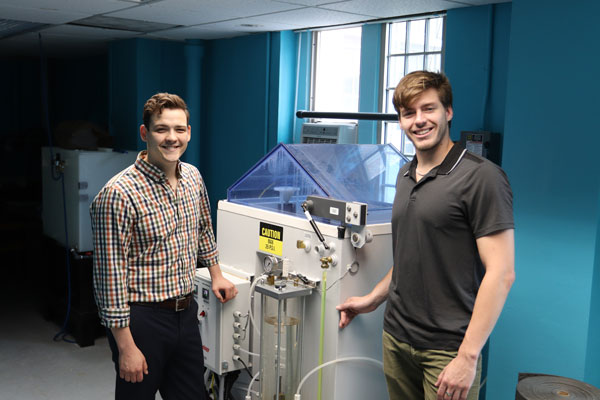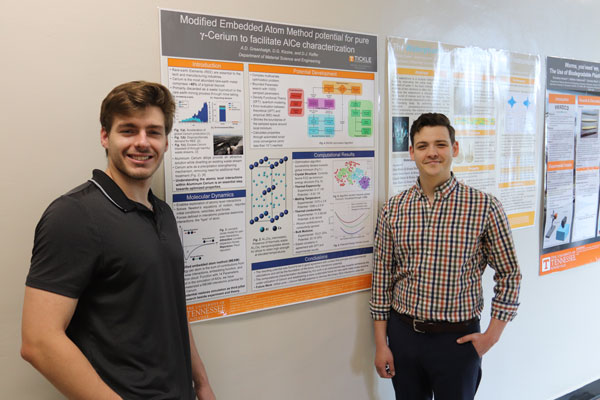
Written by David Keffer. Photography by Randall Brown.
Alex Greenhalgh displayed an early interest in participating in undergraduate research, joining the research group of Professor David Keffer in October 2019 when he had been enrolled at the University of Tennessee for scarcely two months. His interest in using computational tools to solve materials problems quickly became evident. Before he had taken a single materials science class, he was able to bring himself up to speed on the use of radial distribution functions, crystallography, and atomic probe tomography (APT) to characterize the atomic-scale structure of materials. He developed a computational method to statistically characterize chemical ordering in APT data sets of high entropy alloys (HEA) and applied them to an APT experiment of an HEA from the group of John Fisher Professor Peter Liaw. As a freshman, Greenhalgh presented this work to collaborators in the Department of Mathematics from UT’s College of Arts and Science and the Min H. Kao Department of Electrical Engineerign and Computer Science as well as to staff scientists at Oak Ridge National Laboratory. This work led to the interdisciplinary publication of a first author paper co-authored with Keffer, Professor Vasileios Maroulas (Math), and Research Associate Professor Piotr Luszczek (EECS), and others.
Along the way, Greenhalgh developed a mastery of classical molecular dynamics simulation using the LAMMPS software from Sandia National Laboratories. He has used molecular simulation to measure thermodynamic, mechanical, structural, and transport properties of aluminum and aluminum alloys. While at UT, in addition to majoring in materials science and engineering, he pursued a minor in mathematics and computer science, resulting in him becoming a fluent programmer in C++ and Python and developing a deep understanding of machine learning.
Greenhalgh combined these skills in the summer of 2021 when he participated in a Summer Undergraduate Laboratory Internship (SULI) in the Spallation Neutron Source (SNS) at ORNL, the world’s premier facility for using neutrons to characterize the atomic structure of materials. Under the advising of Yuanpeng Zhang, Greenhalgh worked on interfaces to better enable SNS users to extract the most insight from the data that they generated at the site.

In his last two years, Greenhalgh collaborated with Dayton Kizzire, a postdoctoral researcher in MSE, developing interaction potentials for cerium, an emerging candidate for new light-weight, high-temperature aluminum-based alloys. Because a viable interaction potential did not exist, molecular simulation could not be used for new alloy discovery. Greenhalgh and Kizzire’s goal was to restore simulation as the third pillar of research, complementing theory and simulation of AlCe alloys. Their work required the combination of density functional theory (DFT), machine learning and classical molecular dynamics (MD), which resulted in an interaction potential for Ce capable of reproducing cohesive energy, bulk modulus, elastic coefficients, thermal expansivity, thermal conductivity, and many other material properties. At the time of writing, their manuscript is in the review process. Of his relationship with Kizzire, Greenhalgh says, “He has provided guidance on integrating materials science and machine learning in an interdisciplinary space. Conversations with him about his research experiences have cemented my desire to pursue a PhD.”
The caliber of Greenhalgh’s work has been recognized through many national competitions, including (i) the Consortium for Enabling Technologies & Innovation, managed by the Georgia Institute of Technology underwritten by the Department of Energy (DOE) and the National Nuclear Security Administration (NNSA); (ii) selection by the Science, Mathematics, and Research for Transformation (SMART) Scholarshipfor-Service Program, funded by the Department of Defense (DoD); and (iii) the prestigious Barry Goldwater scholarship in March 2022. In spring of 2023, he was named Undergraduate Researcher of the Year by UT. Keffer also earned recognition as Undergraduate Research Mentor of the Year.
Greenhalgh is an Eagle Scout and exemplifies the maturity and traits to which Eagles Scouts aspire. Throughout his time at UT, he has interacted with many professionals both inside and outside the university. His commitment to collegiality and his internal standard of excellence coupled with his technical expertise and work ethic have earned him high praise from all those with whom he has worked. Greenhalgh is off to fulfill his obligations to the DoD through the SMART Scholarship-for-Service Program. He plans to pursue a master’s degree in computer science during this service period and then return to graduate school to earn his doctorate in the broad field of computational science.
Having shared Greenhalgh’s story, it is important to note that it was the financial support from the Center for Materials Processing (CMP) for undergraduate research when Alex was a first-year student that set him on this path to success. Through the financial support of so many undergraduates like him, the CMP continues to plant the seeds of success in the amazing, young materials scientists and engineers at the University of Tennessee.